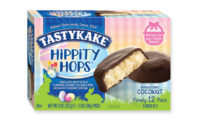Even though consumers have largely been staying home of late due to the COVID-19 pandemic, they are still seeking out desserts and treats like snack cakes. The snack cake portability factor has long been a major plus for the category. Now, consumers also enjoy that they are pre-portioned, and therefore can be enjoyed as a reasonably sized treat.
Overview | Bread | Tortillas | Sweet Goods | Snack Cakes | Pizza | Desserts | Cookies | Buns & Rolls | Bars | Breakfast Products
Market data
According to IRI, Chicago, data from the past 52 weeks ending April 19, 2020 shows bakery snacks up 1.6 percent, with a total of $3.48 billion in sales.
McKee Foods Corp., owner of the Drake’s and Little Debbie brands, was the leader in the category, with a slight increase of 1.1 percent in sales to $857.8 million. The No. 2 company in the category, Hostess Brands, saw $717.5 million in sales and an increase of 1.1 percent. Private label bakery snacks had $676.1 million in sales and a slight dip of 1.0 percent. Grupo Bimbo saw a nice 9.1 percent growth for its bakery snacks, hitting $278.2 million in sales.
Looking back
“Baked snack cakes have a nice fit within the overall snacking trend that continues to evolve with consumers as they have altered their eating habits away from three square meals a day,” says Janelle Crawford, regional marketing lead, DuPont Nutrition & Biosciences, Wilmington, DE. “These products are typically the right single-sized portion and packaged in a way that offers convenience for on-the-go lifestyles. Snack cakes also offer permissible indulgence through a right-sized, full-flavor treat.”
Tactics traditionally associated with this category continue, such as offering new and interesting flavors, including seasonal and limited-time varieties that spark trial, says Crawford. Brand promotion can also sometimes mean going outside of the bakery snacks category. “We’ve seen cobranding and innovation by traditional snack cake brands into adjacent categories. For example, Hostess Brands offers its ‘tasty collabs’ products that include Post Hostess Twinkies and Honey Buns cereals. Victor Allen’s Coffee has also partnered with Hostess to bring flavored coffees, cappuccinos, and hot cocoas inspired by the snack cakes.”
New product launches have also included items that cater to smaller demographic segments: healthier alternatives with vegan, gluten-free, or allergen-free claims, often with products featuring alternative grains and flours, notes Crawford.
Recent proprietary snack research from Cargill, Minneapolis, found strong consumer demand in the snack cakes category, says Jana Mauck, senior strategic marketing manager. “The study showed that consumers enjoyed sweet baked goods, including snack cakes, 9.8 times per month, with 41 percent of consumers surveyed indicating they consumed a sweet baked good a couple times a week.”
Many snack cakes and bakery snacks have right-sized positioning that helps build appeal. “Along with portability, indulgence continues to be prominent in the broader sweet snack category, but morphing to more-permissible indulgence by adding or substituting ingredients that make the product healthier,” says Mauck.
When choosing sweet baked goods, consumers in the snacks survey indicated that 47 percent consider taste and flavor as the main criteria when making a purchase, Mauck says. “The ingredients that bakers choose play a significant role in the taste and flavor of your snack cakes. The fats and oils you choose can impact your final snack cake product by being a flavor carrier, creating a positive mouthfeel experience, and contributing to texture and structure.”
Mini cakes have also been trendy this year. “There has been a large push in the mini cake products, as well as mini muffins,” says Bob Peck, vice president, engineering, E.T. Oakes Corp., Hauppauge, NY. In order to support increased production, machines are seeing increased depositing speeds and larger pan sizes, with multiple products utilizing the same pan configuration, he says.
For bakers, one challenge is often navigating the line between indulgence and better-for-you, says Emily Brau, senior marketing specialist, Cargill Cocoa & Chocolate North America. “The indulgent side remains focused on decadent sensory experiences, with manufacturers highlighting and romanticizing impactful flavors and textures to entice consumers. On the converse, the better-for-you end of the spectrum seeks to appeal to consumers who want to ‘have their cake and eat it too,’ by combining the indulgence expected from snack cakes while simultaneously removing or reducing negatively perceived ingredients and enhancing claims with health halos.”
Brau says that Cargill has a variety of cocoa, chocolate, and compound offerings to meet these needs, including offerings and capabilities such as no artificial flavors or colors, reduced sugar, protein fortification, and organic or non-GMO.
People also want lower levels of sugar, lower levels of fat, says Lars Guldager, innovation center head, Bühler, Copenhagen, Denmark. “Also, we see more and more indulgence—smaller things which are more delicate, more supreme. We also see a small trend with more organic products.”
Bühler has experimented with ingredient substitutions for specialized diets. “We have developed a vegan brownie, an egg-free layer cake, and an egg-free Jaffa cake, and also an egg-free brownie,” says Amaury de Ricqlès, head of product development. For the brownie, they replaced the butter with a trans-fat-free oil. “Also, we worked on replacing flour, in order to be able to have it gluten-free. The trend seems to be making traditional products without some of the traditional ingredients.”
Looking forward
“One of the themes we see in the bakery industry, including snack cakes, is the need to extend shelf life,” says David “Guilley” Guilfoyle, innovation manager, bakery and confectionery, DuPont Nutrition & Biosciences. As retailers require longer shelf life from the manufacturers, the manufacturers inquire more about shelf-life extension beyond 30 days from their suppliers—often pushing boundaries into the “hyperextended” shelf life realm, he says.
“Distribution methods also contribute to this trend. Manufacturers will need to consider product quality from a couple of different aspects, such as maintaining softness and also reducing the amount of oxidation, which causes rancidity,” Guilfoyle notes.
The other aspect that manufacturers need to consider is product safety, as in the use of antimicrobials, adds Guilfoyle. “There are many options for antimicrobials, but the formulators will need to look at the pH level of their finished product to ensure that the antimicrobial they are using still maintains its efficacy at the product’s finished pH. There will be times when the pH should be adjusted to ensure the antimicrobial will still be viable.”
Maintaining softness quality over time can be achieved by the use of enzymes and emulsifiers, says Guilfoyle. “At DuPont, we have seen that when emulsifiers are used with certain amylase enzymes, there is a synergy of softening over longer periods of shelf life. The emulsifier, distilled monoglyceride, will lower the firming curve and lengthen out the curve. The amylase enzyme will continue to maintain softness over the shelf life time from the lower point in that firming curve, thus the emulsifier and enzyme work together to enhance the softness over shelf life.”
DuPont has a range of enzyme solutions specifically tailored for sweet bakery items. The POWERSoft Donut range was developed so manufacturers can say yes to both product quality and extended freshness, says Guilfoyle. “Designed specifically for sweet bakery products such as cake and yeast-raised doughnuts, our latest enzyme technologies will allow a moist, velvety texture and excellent crumb resilience while maintaining these characteristics throughout your desired shelf life.”
Ricqlès says that some consumers will seek out local ingredients in their snack cakes. “For example, in Africa, we are asked to make product similar to European cakes, but using ingredients which are traditionally grown in Africa. The same in India. So we need to develop recipes and processes with those local ingredients, especially without traditional wheat flour, because wheat flour isn’t grown there.”
Sustainability is another key factor in today’s industry. “Sustainability is now really in focus for most of our customers. It is truly one of the decision factors when choosing an equipment. It goes hand-in-hand with our 50-50-50 goal at Bühler: 50 percent less waste, 50 percent less energy, and 50 less water—along the value chain,” Ricqlès says. He points to the high energy efficiency of the Bühler Meincke Turbu oven, and the new Turbu E, presented at the company’s Virtual Interpack. “It takes the same concepts in terms of energy efficiency, but uses electric rods instead of a gas heater. If our customer buys its electricity from a renewable source—like we do here in our factories in Denmark, for example—this Turbu E oven is a true enabler for emission-free cake production.”
Brau says that with consumer lifestyle changes, such as social distancing and self-quarantine as a result of COVID-19, she anticipates an increase in snacking occasions at home, such as more grazing and a greater appreciation for shelf life. “Snack cakes, once popular for their on-the-go portability, ironically will now remain and gain popularity while consumers stay at home and seek products that offer convenience and ease, and serve as a small treat or reward. Familiar and nostalgic flavor choices such as chocolate will remain a go-to for consumers.”
Additionally, indulgent products that are gluten-free, lactose-free, or have reduced sugar will also have a place in consumers’ lives as they acknowledge the importance of making proactive and preventative choices as it relates to their personal health, Brau adds.
Consumers are embracing “permissible indulgences”—sweet treats with a clean, healthy, or better-for-you attribute that helps them rationalize the splurge or mitigate the guilt, says Allison Leibovich, senior technical service specialist for bakery, Cargill. “Plant-based proteins, such as soy flour and pea protein, can be an easy way to accommodate that desire, boosting the protein profile of a snack cake. For example, PURIS pea protein offers a robust protein content, with a minimum of 80 percent protein. Plus, it’s sustainably grown in the U.S. and carries with it plenty of label-friendly consumer appeal.”
Leibovich has also seen steady interest in reduced-sugar baked goods. “Ingredients like chicory root fiber and stevia leaf extract are key to delivering on that demand. Chicory root fiber serves as a bulking agent, enhancing body and mouthfeel in reduced-sugar products, while plant-sourced stevia delivers a clean taste and sweetness, attributes consumers expect with traditional baked goods.”
Leibovich also says that keto-friendly formulations are growing in popularity. “Since the keto diet emphasizes reducing carbohydrates—and hence, sugars—chicory root fiber and stevia play an important role here, too. In addition, ingredients like xanthan gum help to bind water, building viscosity and enhancing texture.” For customers looking for alternative sweetener sources in their snack cakes, options like tapioca syrup and turbinado sugar add body, texture, and mouthfeel as a bulk sweetener, she says.
Jamie Mavec, marketing manager, Cargill, says that Cargill’s PalmAgility shortening line helps fill a gap in its bakery customers’ portfolios by providing a single solution to a range of common challenges—including transportation, storage, and performance. “PalmAgility products help to reduce shortening brittleness across a wider temperature range, allowing customers to store them easily without sacrificing workability or texture. This also helps address issues that can develop in transportation due to fluctuations in outdoor temperatures, a variable outside of customer’s control. In addition, PalmAgility provides a smoother, creamier texture than standard palm oil shortenings. This aids in faster mixing time and better incorporation of all ingredients, both of which are easier on baking equipment.”
Pam Stauffer, global marketing programs manager, Cargill, says that great taste will always be critical to the success of indulgent products like snack cakes, but Cargill’s proprietary consumer snack research suggests consumers increasingly expect more. “Consumers ranked natural sweeteners, increased protein, and organic ingredients as some of the attributes they were most likely to seek in sweet baked goods. However, whether bakers are boosting protein or crafting label-friendly formulations, the challenge is to make the required ingredient adjustments without diminishing sensory appeal, especially in indulgent treats like snack cakes.”
Overview | Bread | Tortillas | Sweet Goods | Snack Cakes | Pizza | Desserts | Cookies | Buns & Rolls | Bars | Breakfast Products








